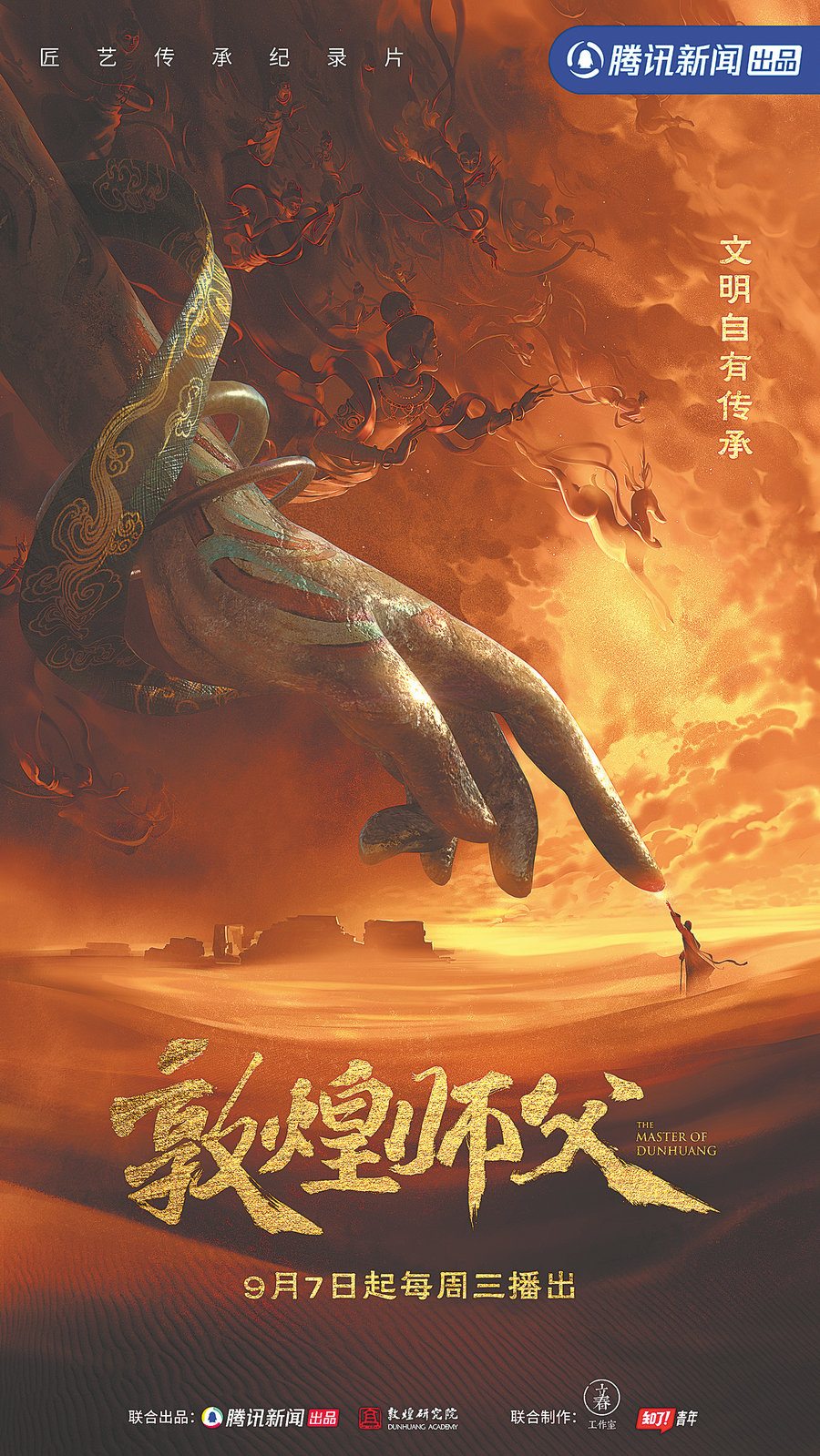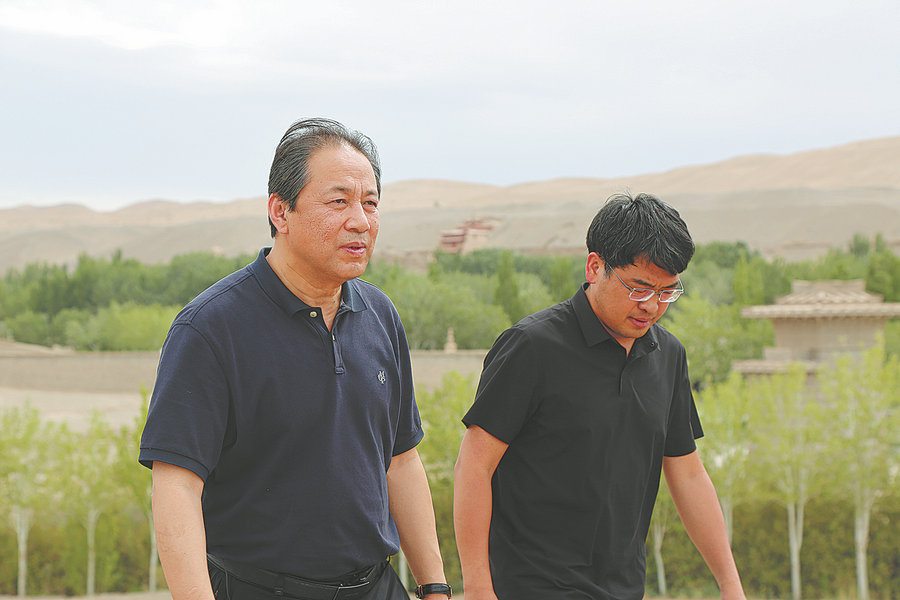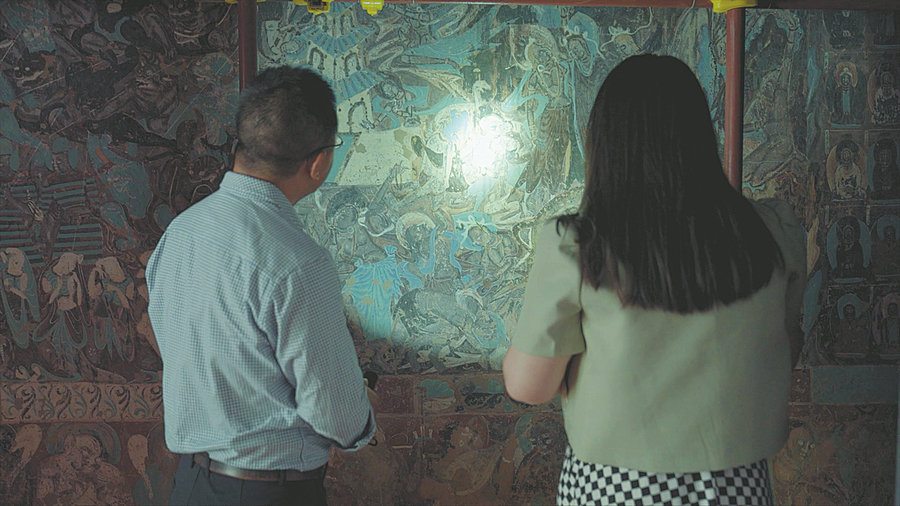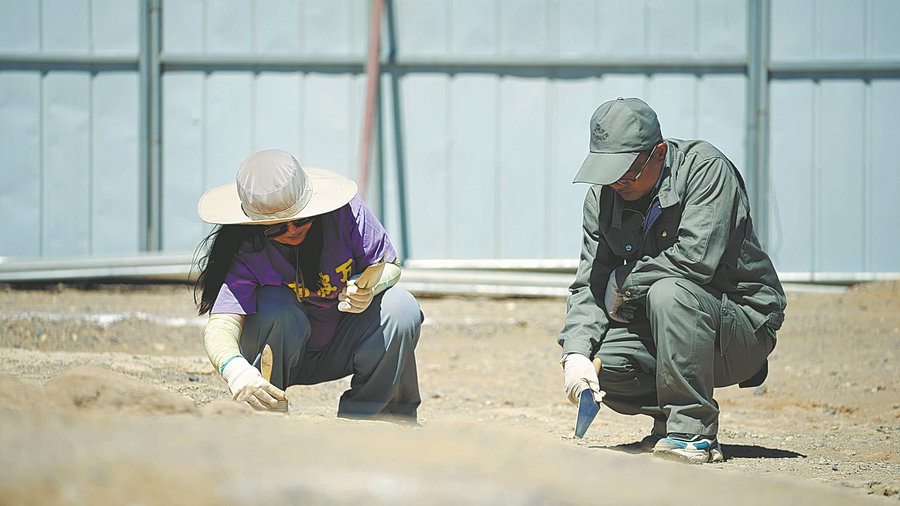
Veteran fresco restorer Li Bo and his protege Li Can examine a mural at the Mogao Caves in Dunhuang, Gansu province. (Photo/China Daily)
Documentary goes behind the scenes to show the work undertaken at world-famous site, Xu Fan reports.
Unlike most of her fellow postgraduates, who landed jobs in big cities such as Shanghai, Zhang Xiaoyang chose to work at Dunhuang Academy when she graduated with her archaeology major at Zhejiang University three years ago.
Despite being the world's largest treasure trove of Buddhist art, living conditions in Dunhuang, which sits in the Gobi Desert in Northwest China's Gansu province, are harsher than in China's metropolises.
Zhang, who is in her late 20s, has an intense routine. Assigned two stressful tasks, she spends most of the day battling sand and wind with the excavation team in Tianwangtang, the relic site of a Buddhist tower that is located on a hill at the Mogao Caves in Dunhuang.
At night, she writes academic reports on the discoveries in Cave 254, which was created during the Northern Wei Dynasty (386-534) and is one of the oldest caves in Dunhuang.
However, the biggest challenge for the young archaeologist is not the workload. It is trying to obtain some academic achievements within her three-year tenure at Dunhuang, a goal she set when she decided to take the job.
Her story is featured in The Master of Dunhuang, a three-episode documentary, currently available on the streaming site Tencent Video, which has garnered a lot of attention online.
Jointly produced by Tencent News and Dunhuang Academy, the project has turned the lens on three pairs of experts at the academy, respectively specializing in artefact restoration, archaeological research and digital recording of the grottoes.
Yang Ruichun, the project's initiator and producer, says that the production team was originally drawn to the splendid artworks in the Mogao Caves, but, after travelling to the far-flung site six times, their interest shifted to those who are devoted to protecting Dunhuang's 1,600-year-old legacy.
For director Li Zhenya, the documentary marks the project he has undertaken that examines the work at Dunhuang, following the celebrity-hosted documentary, The Great Shokunin, and the cultural show, The Mystery of China.
This time, however, Li and his team encountered an unexpected obstacle while attempting to interview the experts.
Recalling that most of the experts seemed shy and reluctant to engage, Li jokes that the production crew must have seemed like wolves harassing a warren of nervous rabbits.
"Dunhuang is surrounded by the vast Gobi Desert, making it more isolated than the most of the country's famous ancient sites, such as Sanxingdui (an archaeological site in Sichuan province) and the Yinxu ruins (located in Henan province)," says Li.
He explains that they believe the distinctive geographical environment makes the experts and craftsmen working at Dunhuang more focused on their work and immersed in their own archaeological world.

A poster for The Master of Dunhuang. (Photo/China Daily)
The documentary crew was soon forced to employ more direct means of engagement with the experts, such as volunteering to assist in the archaeological work by sweeping soil, or moving stones in excavation pits. Through dining and sharing late-night snacks together, the crew managed to get more acquainted with the researchers.
"Due to a shortage of staff, most researchers have to work until very late. Sometimes they were only available around midnight, after busy days attending meetings and writing reports, so we conducted most of the interviews at night," recalls Li.
By delving deeper into the project, the director feels more respect for those who are dedicated to the preservation, restoration and research of the relics at Dunhuang, an area with a total of 45,000 square meters of murals and more than 2,400 sculptures spread throughout in its 735 caves.
"Dunhuang is a place of magic. For those who once planned to work here temporarily, maybe for a few years before moving to bigger cities, many are totally fascinated by the site and have decided to stay for decades," adds Li.
Among them is Zhang Xiaogang, the director of the archaeology institute at Dunhuang Academy. Shown in the second episode as a caring mentor who guides Zhang Xiaoyang, he confides that he once endured similar struggles in his first few years.
After graduating with a master's degree from Wuhan University in 2002, the then 23-year-old Zhang Xiaogang once felt uncomfortable with the dry weather and harsh environment, as he strived to achieve academic recognition in around three years before returning to Wuhan in Central China's Hubei province.
However, his mind was changed by the caring guidance of Fan Jinshi and Peng Jinzhang, two influential scholars, who devoted their lives to the study of ancient Dunhuang culture.
Now, it's his turn to shoulder the responsibility of encouraging young talent to stick to their academic pursuit.
It is no mean feat, as one scene in the documentary shows that, in recent years, Dunhuang Academy has found it difficult to recruit young talent.
The heritage of the craftsmanship spirit is also highlighted in the documentary.
In the first episode, Li Bo, the 58-year-old son of top fresco art restorer Li Yunhe, leads his apprentice in a challenging experiment using his father's method: to entirely remove a layer of one of the frescoes, as the under layer is itself a fresco from an earlier dynasty.
The final tale depicts the internet era's impact on Dunhuang. Yu Tianxiu, head of the academy's institute of cultural relics digitalization, and his team employ advanced technologies, like artificial intelligence, to digitally record the details of the Mogao Caves.
For director Li Zhenya, Dunhuang is like an encyclopedia that draws scholars and researchers from a variety of fields to find their specialist subjects.
"Aside from Buddhist scriptures, many records reveal different aspects of ancient society — for instance, a student's homework and a landlord's contract have been found in the Cangjing (storing scriptures) Cave," adds Li, revealing that he is currently in discussions about producing a second season of the documentary.

Yu Tianxiu, director of the academy's cultural relics digitalization institute, walks with his predecessor, Wu Jian. (Photo /China Daily)

Zhang Xiaogang (left), head of Dunhuang Academy's archaeology institute, discusses the art of murals with young archaeologist Zhang Xiaoyang. (Photo/China Daily)

The two Zhangs at an excavation site. (Photo/China Daily)
Editor: Qian Yingchao (Intern)